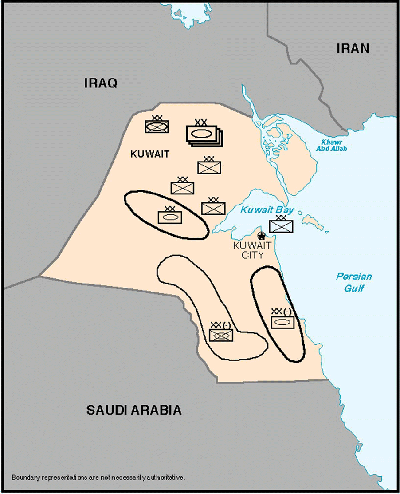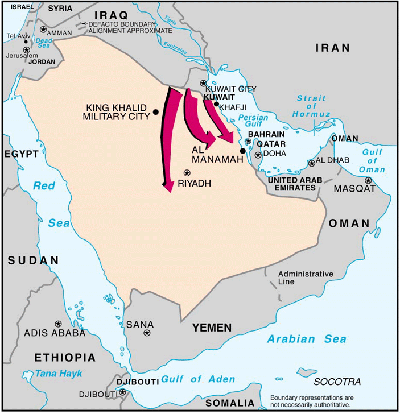|
|
7 August |
DESERT SHIELD
Operation DESERT SHIELD begins (C-Day). The President orders
the deployment of US forces to Saudi Arabia.
CJCS issues deployment orders for initial units to Southwest
Asia.
 |
| Iraqi disposition of forces in Kuwait on 6 August 1990.
Regular army divisions were arriving from garrisons in Iraq, freeing RGFC
units for further employment. |
ITF assumes a 24-hour, 7-day week analytical and support status.
NMIST personnel and equipment deploy with CENTAF to Riyadh.
Joint Reconnaissance Center (JRC)/DC-1 confirms that the 3
RC-135's currently at Athens will deploy to Saudi Arabia once permission
is granted.
DC-1 requests that the Air Force Staff project costs for the SR-71 reactivation. |
7-10
August |
DSD-3 (General Military Intelligence Support Division) develops
the procedure for including the general military intelligence (GMI) air,
ground, and naval order of battle daily updates into the Automated Installation
Intelligence File (AIF). |
8 August |
President announces US deployments to "defensive position"
and reiterates four policy objectives.
First fighter aircraft of the USAF 1st Tactical Fighter Wing arrives in
Saudi Arabia.
CINCCENT recommends to the JCS that operations be called PENINSULA
SHIELD. That name is rejected in favor of DESERT SHIELD, recommended by
the CINC's staff.
NMISTs deploy to XVIII Airborne Corps, US Marine Central Command
(MARCENT), and US Navy Central Command (NAVCENT).
DIA receives a CENTCOM request for information on Iraqi reaction
to arrival of XVIII Airborne Corps troops in Saudi Arabia.
|
9 August |
UN Security Council condemns Iraq's annexation of Kuwait as
illegal, null, and void.
CENTCOM headquarters advanced party arrives in Riyadh.
Lead Army elements of the 82nd Airborne Division arrive in
Saudi Arabia.
DI-6 grants authority to release OLYMPIC FLARE imagery to
Coalition Forces (military forces Contributed by countries allied against
Iraq).
|
10 August |
DIA issues HUMINT tasking to provide the location and description
of key Iraqi government facilities.
DC receives request from Navy for coverage of the port of Umm Qasr to monitor
Iraq's mining operations. |
12 August |
DIA issues worldwide HUMINT tasking to begin tracking merchant
ships to monitor support of the UN embargo against Iraq. |
13 August |
DI-6 completes guidance for intelligence sharing with Coalition
Forces. |
15 August |
DIA sends team to CENTCOM (Rear) at McDill AFB to discuss
foreign disclosure, development of an all-source fusion center, production
coordination, and targeting/operational issues.
DAT-6 provides personnel for HUMINT representation on the
ITF.
DAH begins providing daily DoD HUMINT collection activity
summary to ITF/CCF (Collection Coordination Facility).
OSC-2 (Physical/Tempest Security Division, Directorate for
Security and Counterintelligence) provides security recommendations for
the
multinational environment of the CENTCOM Sensitive Compartmented
Information Facility (SCIF).
DX-5 begins production of OSP's on the top 43 primary targets
on CENTCOM's target list.
DX-6 expands its reporting in both the Significant Imagery
Highlights Book and daily briefings to the JS, to include the status of
Iraqi shipping after enactment of the UN embargo. |
16 August |
DoD designates DIA as Executive Agent for DESERT SHIELD imagery
collection.
The Clarendon Operations Support Center begins a 24-hour watch.
DM-1 consolidates instructions for use and distribution of
NARROW SANDS F-14 Tactical Air Reconnaissance Pod System (TARPS) information. |
17 August |
DAT-6 receives information indicating Iraq plans to use Western
"detainees" as human shields.
DIA begins publication of the Military Situation Summary (MSS)
at the OICC.
DIA begins analysis of Iran/Iraq POW history, to include POW
camp locations, treatment of POW's, and procedures.
DIA Director orders that all Scud sites be placed in active
collection.
DC reports that a CCF Imagery Officer is required at the following
daily meetings:
0400 - Teleconference room with the OICC (to accept proposed
targets for the next day)
0600 - JS update
0730 - DC morning brief
1145 - JS (for JS's emphasis requirements)
1400 - DIA discussion on requirements
1500 - Community imagery meeting
1730 - Task Force evening wrap-up meeting
2000 - OICC |
SCUD/AL HUSAYN
TRANSPORTER ERECTOR LAUNCHER (EL)
|
 |
Drawing of the Iraqi version of the missile prepared by DIA Public Affairs
(DI-PA) for public and media release. |
|
|
|
19 August |
NMIST deploys to UK Strike Command in High Wycombe, UK.
DIA publishes first DESERT SHIELD Bulletin. |
20 August |
DIA orders the establishment of a Department of Defense
Joint Intelligence Center (DoDJIC) at the Pentagon at the request of the
CJCS to fuse the efforts of DIA and the Military Services. |
|
|
|
DIA Deputy Director asks DR-BT to develop and maintain
a brief on DIA intelligence support to DESERT SHIELD.
DM-1 makes initial distribution of OLYMPIC FLARE airborne imagery highlights.
OICC meets with RS to establish prioritization of RS support to DESERT SHIELD
activities (photo lab, graphics, distribution, library, and print shop).
DAT-6 attends tri-service collection manager meeting to discuss DoD/CENTCOM
HUMINT tasking in support of DESERT SHIELD. A worldwide HUMINT tasking update
message is dispatched as a result. |
21 August |
DIA lifts ban on release of chemical warfare (CW) and biological
warfare (BW) data. This is done so DIA can provide CW/BW information to
CENTCOM which can then pass it on to the Coalition Forces.
|
22 August |
DIA Representative to CENTCOM deploys with the headquarters
element to Riyadh, one of only two civilians that General Schwarzkopf allows
to deploy permanently forward with him.
DI-6 requests amended release authority to Coalition Forces (granted 19
Sep). |
23 August |
DIA forms provisional DoDJIC with three teams of Agency
personnel. (The DoDJIC produced daily situation summaries and assessments
as well as short suspense reporting and analysis. It also had several special
production elements added during the course of its existence). DoDJIC operates
with
299 personnel at its peak.
DI-6 grants approval for British, Canadian, and Australian
officers to work in the OICC.
DIA initiates action to obtain access to Iraqi defectors in Saudi Arabia. |
(Click on Map to see image.) |
 |
| Iraqi avenues of approach for a followup invasion of Saudi
arabia. |
|
| 24 August |
DC receives State Department request for imagery of the Jordanian/Iraqi
border to gauge refugee congestion (for embassy evacuation convoy route
planning). |
25 August |
DIA forwards draft concept of operations (CONOPS) for Defense
Intelligence support to CENTCOM.
DIA participates in wargaming of US options against Iraq. Results lead to
major changes to CENTCOM warplan.
VP arranges for three Multimedia Information Network Exchange (MINX) terminals
to be installed in the OICC for connectivity to ITF.
|
26 August |
DC assigns priority to locating Iraqi Republican Guard
units.
DC-1 prepares a background paper on reactivation of SR-71. |
28 August |
DC assigns high priority collection to monitor Republican
Guard and UN embargo enforcement. |
29 August |
DS (Directorate for Information Systems) provides proposal
to CENTCOM and CENTCOM (Rear) through the DIA Representative for DIA intelligence
automation communications support for DESERT SHIELD.
DIA assumes management responsibility for target material (TM) production.
DAT-6 sends collection guidance message worldwide to reinforce the need
to report any attempts to circumvent the quarantine against Iraq. |
30 August |
Military Services commit to the DoDJIC. The mission of
the DoDJIC is to provide short suspense intelligence tailored to both theater
and Washington consumers.
DSD-3 begins daily update processing of air order of battle (AOB), ground
order of battle (GOB), naval order of battle (NOB), and AIF information
into the Integrated Data Base (IDB).
DIA Deputy Director tasks DIA Historian with writing a history of Defense
Intelligence support to DESERT SHIELD. Historian begins collecting documents
and identifies requirement to key DIA officials. |
31 August |
OICC ships first of 14 OSPs to CENTCOM.
ITF modifies manning structure to four teams working 12-hour shifts, seven
days a week.
DIA delivers first escape and evasion (E&E) study to
CENTCOM.
DAT-6 tasks HUMINT sources to report Kuwaiti resistance efforts. |
August-
September |
Missile and Space Intelligence Center (MSIC) provides six
air defense analysts to DIA/OICC to assist in providing 24-hour intelligence
support on Iraqi air defense operations.
Foreign Science and Technology Center (FSTC) provides three
chemical warfare analysts to assist DIA's CW/BW analytical cell at
the OICC. |
1-30 |
|
September |
DI-6 sends sanitized Defense Intelligence Memoranda (DIM)
and orders of battle to CENTCOM. |
1 |
|
September |
DIA asset obtains an Iraqi sea mine and arranges to have
it flown to the US for exploitation. |
2 |
|
September |
DoDJIC becomes fully operational with DIA and Service (Army
and Navy) manning.
VP establishes Order of Battle Scrub Team in Building 213, Washington Navy
Yard.
|
| 5 |
|
| September |
JS directs DX-6 and DX-7 (Systems, Technology, and Resources Division,
Directorate for Imagery Exploitation) to develop a Scud strategy.
DX and DB (Directorate for Research) begin work on a scrub of the
AIF in an effort to ensure the accuracy of the warfighting data base. |
| 6 |
|
| September |
Air Force adds manning to DoDJIC. |
| 7 |
|
| September |
DoDJIC produces first (published twice daily) Defense Special Assessment
(DSA).
|
|
|
| 8 |
|
| September |
DIA sends Assistant DIO for Middle East/South Asia to Riyadh to serve
as CINCCENT interpreter. |
| 9 |
|
| September |
DX assigns 11 imagery analysts to the DoDJIC and transfers production
of map overlay responsibility for Iraqi forces south of 31 degrees latitude.
DX-5 then initiates production of overlay reporting on Iraqi forces north
of 31 degrees. |
| 10 |
|
| September |
NMIST deploys to United States European Command (EUCOM).
DoDJIC produces first daily MSS after responsibility is transferred
from OICC.
DM-1 consolidates instructions for use and distribution of EAGER LIGHT
imagery information.
DSO (Directorate for Systems Operations) installs Advanced Imagery
Requirements and Exploitation System (AIRES) in the DoDJIC. |
| 10-13 |
|
| September |
DS Automation Task Force (ATF) visits CENTCOM, US Special Operations
Command (SOCOM), US Army Forces Command (FORSCOM), US Tactical Air Command
(TAC), US Atlantic Command (LANTCOM). |
11 |
|
September |
DIA initiates a 24-hour border watch to report sanctions
violations of goods moving into Iraq. |
14 |
|
September |
CENTCOM requests that DIA readout DESERT SHIELD Battle
Damage Assessments (BDA) imagery. |
15 |
|
September |
Initially situated in the CCF, DIA collection management
element relocates to the DoDJIC.
Collection and imagery representatives begin 24-hour duty in OICC management
cell. |
17 |
|
September |
NMIST deploys to CENTCOM. |
18 |
|
September |
DS ATF briefs DIA-CS (Directorate for Command Support and
Plans) on recommendations/findings from 10-13 September visit to CENTCOM.
|
20 |
|
September |
DS begins to look at actions required to pass data base information
between DIA and CENTCOM. Specific requirement is to pass daily Iraqi OB
information to CENTCOM in a timely manner.
First reservist reports for duty in VP. |
|
|
21 |
|
| September |
DX delivers first gridded reference graphics (GRG) to CENTCOM.
|
| 25 |
|
| September |
CENTCOM requests the CCF pass any "hot" news directly via secure
phone to keep them "in the loop."CENTCOM is currently eight days
behind Washington, DC in imagery reporting.
DIA and the Defense Courier Service (DCS) establish the "Desert Line"courier
system to expedite OSP and TM delivery to CENTCOM and its warfighting components. |
| 26 |
|
| September |
DI-4 arranges for Kuwaiti officials' visit to DIA.
|
27 |
|
September |
Last of USDAO Baghdad personnel evacuate with other members
of the US Embassy staff.
|